Instructions for Side by Side Printing
- Print the notecards
- Fold each page in half along the solid vertical line
- Cut out the notecards by cutting along each horizontal dotted line
- Optional: Glue, tape or staple the ends of each notecard together
Central Science: Chapter 5
front 1 Objects can possess energy as ________. (a) endothermic energy A) a only | back 1 E |
front 2 The internal energy of a system is always increased by
________. | back 2 A |
front 3 The internal energy of a system ________. | back 3 D |
front 4 Which one of the following conditions would always result in an
increase in the internal energy of a system? | back 4 D |
front 5 When a system ________, ΔE is always negative. | back 5 B |
front 6 Which one of the following is an endothermic process? | back 6 E |
front 7 Which one of the following is an exothermic process? | back 7 D |
front 8 Of the following, which one is a state function? | back 8 A |
front 9 Which of the following is a statement of the first law of
thermodynamics? | back 9 D |
front 10 The internal energy can be increased by ________. (a) transferring heat from the surroundings to the system A) a only | back 10 D |
front 11 A ________ ΔH corresponds to an ________ process. | back 11 B |
front 12 A ________ ΔH corresponds to an ________ process. | back 12 C |
front 13 ΔH for an endothermic process is ________ while ΔH for an exothermic
process is ________. | back 13 E |
front 14 For a given process at constant pressure, w is positive. This means
that the process involves ________. | back 14 A |
front 15 Which one of the following statements is true? | back 15 C |
front 16 All of the following statements are true except ________. | back 16 E |
front 17 A chemical reaction that absorbs heat from the surroundings is said
to be ________ and has a ________ ΔH at constant pressure. | back 17 A |
front 18 A chemical reaction that releases heat to the surroundings is said to
be ________ and has a ________ ΔH at constant pressure. | back 18 C |
front 19 The reaction 4Al (s) + 3O2 (g) → 2 Al2O3 (s) ΔH° = -3351 kJ | back 19 C |
front 20 When ________ is constant, the enthalpy change of a process equal to
the amount of heat transferred into or out of the system? | back 20 E |
front 21 The units of heat capacity are ________. | back 21 B |
front 22 The units of specific heat are ________. | back 22 C |
front 23 The term Btu which stands for ________ is commonly used in
engineering applications. | back 23 C |
front 24 Which of the following is a statement of Hess's law? | back 24 A |
front 25 For which one of the following reactions is ΔH°rxn equal to the heat
of formation of the product? | back 25 B |
front 26 Of the following, ΔH°f is not zero for ________. | back 26 D |
front 27 Of the following, ΔH°f is not zero for ________. | back 27 A |
front 28 Consider the following two reactions: A → 2B ΔH°rxn = 456.7 kJ/mol Determine the enthalpy change for the process: 2B → C | back 28 A |
front 29 In the reaction below, ΔH°f is zero for ________. A) Ni (s) | back 29 A |
front 30 For the combustion reaction of methane, ΔH°f is zero for
________. A) O2 (g) | back 30 A |
front 31 For the following reactions, the ΔH°rxn is NOT equal to ΔH°f for the
product except for ________. | back 31 C |
front 32 For the following reactions, the ΔH°rxn is NOT equal to ΔH°f for the
product except for ________. | back 32 B |
front 33 For the following reactions, the ΔH°rxn is NOT equal to ΔH°f for the
product except for ________. | back 33 D |
front 34 For the following reactions, the ΔH°rxn is NOT equal to ΔH°f for the
product except for ________. | back 34 E |
front 35 For the following reactions, the ΔH°rxn is NOT equal to ΔH°f for the
product except for ________. | back 35 E |
front 36 The term standard conditions with respect to enthalpy change means
________. | back 36 C |
front 37 The energy released by combustion of ________ of a substance is
called the fuel value of the substance. | back 37 E |
front 38 Fuel values of hydrocarbons increase as the ________
increases. | back 38 B |
front 39 ________ yields the highest fuel value. | back 39 A |
front 40 All of the following are considered fossil fuels except
________. | back 40 A |
front 41 The most abundant fossil fuel is ________. | back 41 C |
front 42 Calculate the kinetic energy in J of an electron moving at 6.00 ×
106 m/s. The mass of an electron is 9.11 × 10-28
g. | back 42 C |
front 43 Calculate the kinetic energy in joules of an automobile weighing 2135
lb and traveling at 55 mph. | back 43 B |
front 44 Calculate the kinetic energy in joules of an automobile weighing 4345
lb and traveling at 75 mph. | back 44 C |
front 45 The kinetic energy of a 7.3 kg steel ball traveling at 18.0 m/s is
________ J. | back 45 A |
front 46 The kinetic energy of a 10.3 g golf ball traveling at 48.0 m/s is
________ J. | back 46 C |
front 47 Calculate the kinetic energy in joules of a 150 lb jogger (68.1 kg)
traveling at 12.0 mile/hr (5.36 m/s). | back 47 C |
front 48 What is the kinetic energy of a 55.2 g object moving at 135
m/s. | back 48 A |
front 49 The kinetic energy of a 23.2-g object moving at a speed of 81.9 km/hr
is ________ J. | back 49 E |
front 50 What is the kinetic energy of a 145 g baseball traveling at 89.9
mi/hr? | back 50 E |
front 51 A 100-watt electric incandescent light bulb consumes ________ J of
energy in 24 hours. [1 Watt (W) = 1 J/sec] | back 51 E |
front 52 The ΔE of a system that releases 12.4 J of heat and does 4.2 J of
work on the surroundings is ________ J. | back 52 D |
front 53 The ΔE of a system that absorbs 12.4 J of heat and does 4.2 J of work
on the surroundings is ________ J. | back 53 E |
front 54 The change in the internal energy of a system that absorbs 2,500 J of
heat and that does 7,655 J of work on the surroundings is ________
J. | back 54 C |
front 55 The change in the internal energy of a system that releases 2,500 J
of heat and that does 7,655 J of work on the surroundings is ________
J. | back 55 A |
front 56 Hydrogen gas and bromine gas react to form hydrogen bromide gas. How
much heat (kJ) is released when 155 grams of HBr is formed in this
reaction? ΔH° = -72 kJ. | back 56 B |
front 57 The value of ΔH° for the reaction below is -126 kJ. ________ kj are released when 2.00 mol of NaOH is formed in the reaction? 2Na2O2 (s) + 2H2O (l) → 4NaOH (s) + O2 (g) A) 252 | back 57 B |
front 58 The value of ΔH° for the reaction below is -790 kJ. The enthalpy
change accompanying the reaction of 0.95 g of S is ________ kJ. A) 23 | back 58 C |
front 59 The value of ΔH° for the reaction below is -6535 kJ. ________ kJ of
heat are released in the combustion of 16.0 g of (l)? A) 1.34 × 103 | back 59 C |
front 60 Carbon monoxide and oxygen gas react to form carbon dioxide. How much
heat is released when 89.5 grams of O2 (g) reacts with excess CO? ΔH°
= -482 kJ. | back 60 A |
front 61 The value of ΔH° for the reaction below is -336 kJ. Calculate the heat (kJ) released to the surroundings when 23.0 g of HCl is formed. CH4 (g) + 3Cl2 (g) → CHCl3 (l) + 3HCl (g) A) 177 kJ | back 61 C |
front 62 How much heat is released when 29.5 grams of Cl2 (g) reacts with excess hydrogen? H2 (g) + Cl2 (g) → 2HCl (g) ΔH° = -186 kJ. A) 186 kJ | back 62 E |
front 63 The enthalpy change for the following reaction is -483.6 kJ: 2H2 (g) + O2 (g) → 2H2O (g) Therefore, the enthalpy change for the following reaction is
________ kJ. | back 63 B |
front 64 The value of ΔH° for the reaction below is +128.1 kJ: CH3OH (l) → CO (g) + 2H2 (g) | back 64 B |
front 65 The value of ΔH° for the reaction below is +128.1 kJ: CH3OH (l) → CO (g) + 2H2 (g) | back 65 A |
front 66 The value of ΔH° for the reaction below is +128.1 kJ: CH3OH (l) → CO (g) + 2H2 (g) | back 66 D |
front 67 CH3OH (l) decomposes into carbon monoxide and hydrogen gas in the
presence of heat. How much heat is consumed when 5.75 g of CO (g) is
formed? ΔH° = +128.1 kJ. | back 67 A |
front 68 The value of ΔH° for the reaction below is -1107 kJ: 2Ba (s) + O2 (g) → 2BaO (s) | back 68 D |
front 69 The value of ΔH° for the reaction below is -1107 kJ: 2Ba (s) + O2 (g) → 2BaO (s) | back 69 C |
front 70 How many kJ of heat are released when 15.75 g of Ba (s) reacts
completely with oxygen gas to form BaO (s)? ΔH° = -1107 kJ. | back 70 A |
front 71 The molar heat capacity of an unknown substance is 92.1 J/mol-K. If
the unknown has a molar mass of 118 g/mol, what is the specific heat
(J/g-K) of this substance? | back 71 D |
front 72 The specific heat capacity of lead is 0.13 J/g-K. How much heat (in
J) is required to raise the temperature of of lead from 22 °C to 37
°C? | back 72 D |
front 73 The temperature of a 15-g sample of lead metal increases from 22 °C
to 37 °C upon the addition of 29.0 J of heat. The specific heat
capacity of the lead is ________ J/g-K. | back 73 D |
front 74 What is the molar heat capacity (in J/mol-K) of liquid bromine? The
specific heat of liquid bromine is 0.226 J/g-K. | back 74 A |
front 75 The specific heat of liquid bromine is 0.226 J/g-K. How much heat (J)
is required to raise the temperature of 10.0 mL of bromine from 25.00
°C to 27.30 °C? The density of liquid bromine: 3.12 g/mL. | back 75 B |
front 76 ΔH for the reaction IF5 (g) → IF3 (g) + F2 (g) is ________ kJ, given the data below. IF (g) + 2F2 (g) → IF5 (g) ΔH = -745 kJ A) +355 | back 76 A |
front 77 Given the following reactions 3Fe (s) + 4CO2(s) → 4CO (g) + Fe3O4(s) ΔH = +12.5 kJ the enthalpy of the reaction of Fe2O3 with CO is ________ kJ. | back 77 A |
front 78 Given the following reactions 2NO (g) + O2 (g) → 2NO2 (g) ΔH = -114.2 kJ is ________ kJ. | back 78 A |
front 79 Given the following reactions 2NO + O2 → 2NO2 ΔH = -112 kJ the enthalpy of the reaction of nitrogen with oxygen to produce nitrogen dioxide N2 + 2O2 → 2NO2 is ________ kJ. | back 79 A |
front 80 Given the following reactions S (s) + O2 (g) → SO2(g) ΔH = -297 kJ the enthalpy of the reaction in which sulfur dioxide is oxidized to sulfur trioxide 2SO2 (g) + O2 (g) → 2SO3 (g) is ________ kJ. | back 80 B |
front 81 Given the following reactions is ________ kJ. | back 81 B |
front 82 Given the following reactions is ________ kJ. | back 82 D |
front 83 Given the following reactions N2 (g) + O2 (g) → 2NO (g) ΔH = +180.7 kJ is ________ kJ. | back 83 B |
front 84 Given the following reactions is ________ kJ. | back 84 C |
front 85 Given the following reactions is ________ kJ. | back 85 D |
front 86 The value of ΔH° for the reaction below is -186 kJ. The value of ΔH°f for HCl (g) is ________ kJ/mol. | back 86 C |
front 87 The value of ΔH° for the following reaction is -3351 kJ: | back 87 B |
front 88 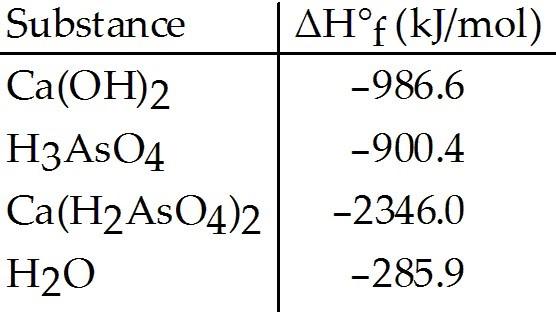 Given the data in the table, ΔH°rxn for the reaction Ca(OH)2 + 2H3AsO4 → Ca(H2AsO4)2 + 2H2O is ________ kJ. A) -744.9 | back 88 D |
front 89  Given the data in the table, ΔH°rxn for the reaction 4NH3 (g) + 5O2 (g) → 4NO (g) + 6H2O (l) is ________ kJ. A) -1172 | back 89 A |
front 90 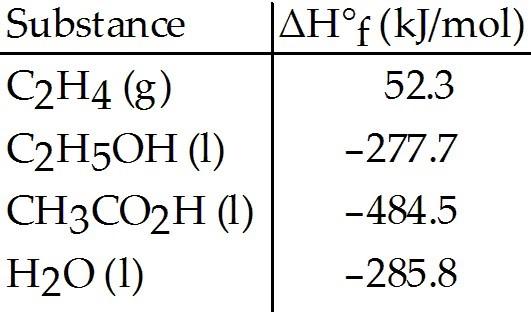 Given the data in the table, ΔH°rxn for the reaction is ________ kJ. A) -79.0 | back 90 D |
front 91 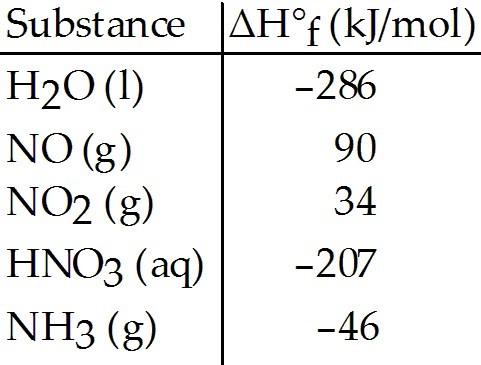 Given the data in the table, ΔH°rxn for the reaction is ________ kJ. A) 64 | back 91 C |
front 92 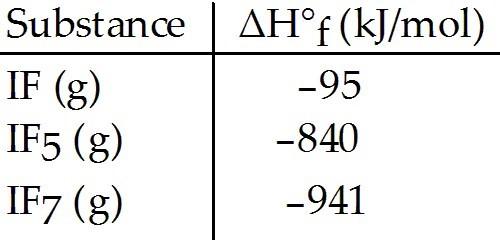 Given the data in the table, ΔH°rxn for the reaction IF5 (g) + F2 (g) → IF7 (g) is ________ kJ. A) 1801 | back 92 E |
front 93 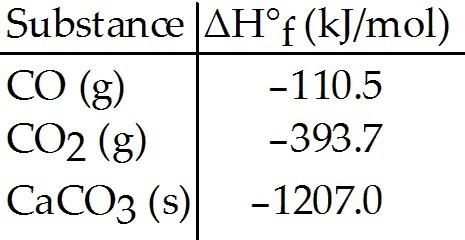 Given the data in the table, ΔH° for the reaction is ________ kJ. A) -566.4 | back 93 A |
front 94  The value of ΔH° for the following reaction is 177.8 kJ. The value of
Δ for CaO(s) is ________ kJ/mol. A) -1600 | back 94 C |
front 95 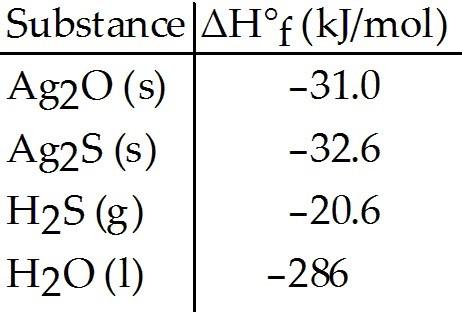 Given the data in the table, ΔH°rxn for the reaction is ________ kJ. A) -1.6 | back 95 D |
front 96 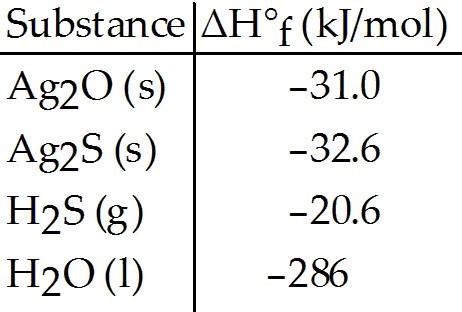 Given the data in the table, ΔH°rxn for the reaction is ________ kJ. A) -267 | back 96 A |
front 97 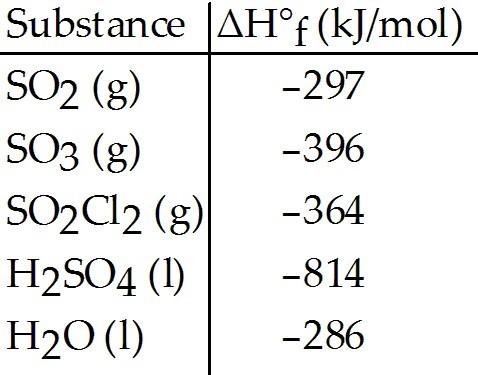 Given the data in the table, ΔH°rxn for the reaction is ________ kJ. A) -99 | back 97 C |
front 98 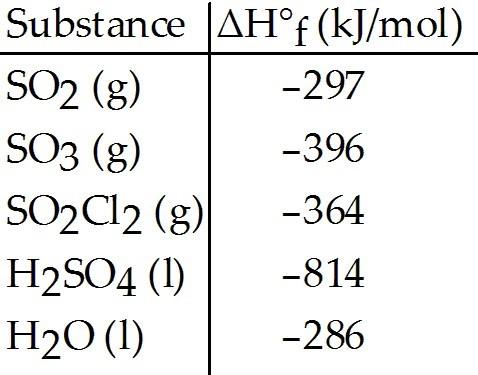 Given the data in the table, ΔH°rxn for the reaction is ________ kJ. A) -132 | back 98 A |
front 99  Given the data in the table, ΔH°rxn for the reaction is ________ kJ. A) -385.77 | back 99 B |
front 100 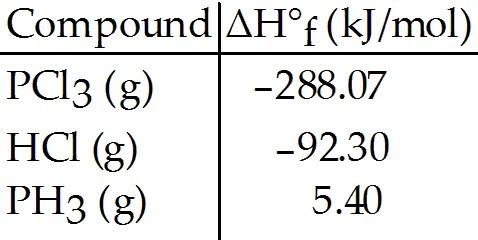 Given the data in the table, ΔH°rxn for the reaction is ________ kJ. A) -570.37 | back 100 C |
front 101 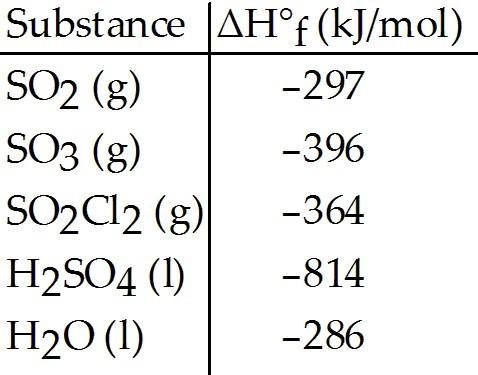 Given the data in the table and ΔH°rxn for the reaction ΔH°f of HCl (g) is ________ kJ/mol. A) -184 | back 101 C |
front 102 A 19.5 g candy bar contains 8% protein, 33% fat, and 18%
carbohydrate. The respective fuel values for protein, fat, and
carbohydrate are 17, 38, and 17 kJ/g, respectively. What is the fuel
value (kJ) for this piece of candy? | back 102 B |
front 103 A 3.00 L pitcher of sweetened ice tea contains 600. g of sugar.
Assuming that the sugar is the only fuel source, what is the fuel
value (in kJ) of a 250. mL serving? The respective fuel values for
protein, fat, and carbohydrate are 17, 38, and 17 kJ/g, respectively.
| back 103 A |
front 104 A typical fast food meal consists of a burger, fries, and a
soft-drink and contains 58.0 grams of fat, 39.0 grams of protein, and
177 grams of carbohydrate. If jogging burns 950.0 kJ/hour, how many
minutes would it take to completely burn off the meal? The respective
fuel values for protein, fat, and carbohydrate are 17, 38, and 17
kJ/g, respectively. | back 104 C |
front 105 A slice of cake contains 29.0 grams of fat, 9.0 grams of protein, and
77 grams of carbohydrate. If swimming burns 1000.0 kJ/hour, how many
minutes would it take to completely burn off the slice of cake? The
respective fuel values for protein, fat, and carbohydrate are 17, 38,
and 17 kJ/g, respectively. | back 105 A |
front 106 A 26.9 g rock rolls down the hill at a speed of 81.9 m/s . What is
the kinetic energy of the rock? | back 106 A |
front 107 A 23.2 g piece of space debris is traveling at 81.9 m/s. What is the
kinetic energy of the space debris? | back 107 E |
front 108 At what velocity (m/s) must a object be moving in order to possess a
kinetic energy of 1.0J? | back 108 A |
front 109 At what velocity (m/s) must a 417.3 g object be moving in order to
possess a kinetic energy of 3.2J? | back 109 A |
front 110 When work is done on a system, w will be a ________ value. | back 110 A |
front 111 The value of ΔE for a system that performs 139 kJ of work on its
surroundings and gains of heat is ________ kJ. | back 111 A |
front 112 The value of ΔE for a system that performs 19 kJ of work on its
surroundings and loses of heat is ________ kJ. | back 112 A |
front 113 Calculate the work (kJ) done during a reaction in which the internal
volume expands from to against an outside pressure of 2.5atm. | back 113 A |
front 114 Calculate the work (kJ) done during a reaction in which the internal
volume expands from to against a vacuum (an outside pressure of 0
atm). | back 114 A |
front 115 Calculate the work (kJ) done during a reaction in which the internal
volume contracts from to against an outside pressure of 4.4
atm. | back 115 A |
front 116 The value of ΔE for a system that performs 151 kJ of work on its
surroundings and loses 79 kJ of heat is ________ kJ. | back 116 B |
front 117 Calculate the value of ΔE in joules for a system that loses 115 J of
heat and has 150 J of work performed on it by the
surroundings. | back 117 C |
front 118 The value of ΔH° for the reaction below is -72 kJ. ________ kJ of heat are released when 5.5 mol of HBr is formed in this reaction. H2 (g) + Br2 (g) → 2HBr (g) A) 144 | back 118 D |
front 119 The value of ΔH° for the reaction below is -126 kJ. The amount of heat that is released by the reaction of 10.0 g of Na2O2 with water is ________ kJ. 2Na2O2 (s) + 2H2O (l) → 4NaOH (s) + O2 (g) A) 8.08 | back 119 A |
front 120 The value of ΔH° for the reaction below is -482 kJ. Calculate the
heat (kJ) released to the surroundings when 10.0 g of CO (g) reacts
completely. A) 2410 kJ | back 120 C |
front 121 In the presence of excess oxygen, methane gas burns in a constant-pressure system to yield carbon dioxide and water: CH4 (g) + 2O2 (g) → CO2 (g) + 2H2O (l) △H = -890.0 kJ Calculate the value of q (kJ) in this exothermic reaction when 1.80
g of methane is combusted at constant pressure. | back 121 A |
front 122 Hydrogen peroxide decomposes to water and oxygen at constant pressure
(△H = -196 kJ). What is the value of q (kJ) for this reaction when
4.60 g of hydrogen peroxide decomposes at constant pressure? | back 122 E |
front 123 The combustion of titanium with oxygen produces titanium dioxide: Ti (s) + O2(g) → TiO2 (s) When 0.610 g of titanium is combusted in a bomb calorimeter, the
temperature of the calorimeter increases from 25.00 °C to 50.50 °C. In
a separate experiment, the heat capacity of the calorimeter is
measured to be 9.84 kJ/K. The heat of reaction for the combustion of a
mole of Ti in this calorimeter is ________ kJ/mol. | back 123 E |
front 124 A sample of aluminum metal absorbs 11.2 J of heat, upon which the
temperature of the sample increases from 23.2 °C to 30.5 °C. Since the
specific heat capacity of aluminum is 0.90 J/g-K, the mass of the
sample is ________ g. | back 124 B |
front 125 A sample of calcium carbonate [CaCO3 (s)] absorbs of heat, upon which
the temperature of the sample increases from 20.8 °C to 27.3 °C. If
the specific heat of calcium carbonate is what is the mass (in grams)
of the sample? | back 125 A |
front 126 How many joules of heat are absorbed when the temperature of a 13.9 g
sample of CaCO3 (s) increases from 21.7 °C to 33.3 °C? Specific heat
of calcium carbonate is 0.82 J/g-K. | back 126 A |
front 127 An 6.11 g sample of calcium carbonate [CaCO3 (s)] absorbs of heat,
upon which the temperature of the sample increases from 19.2 °C to
35.9 °C. What is the specific heat of calcium carbonate? | back 127 A |
front 128 A sample of iron absorbs 81.0 J of heat, upon which the temperature
of the sample increases from 19.7 °C to 28.2 °C. If the specific heat
of iron is 0.450 J/g-K, what is the mass (in grams) of the
sample? | back 128 A |
front 129 The temperature of a 35.1 g sample of iron increases from 24.6 °C to
31.8 °C If the specific heat of iron is 0.450 J/g-K, how many joules
of heat are absorbed? | back 129 A |
front 130 A 22.9 g sample of iron absorbs 155 J of heat, upon which the
temperature of the sample increases from 23.9 °C to 38.9 °C. What is
the specific heat of iron? | back 130 A |
front 131 The specific heat capacity of liquid water is 4.18 J/g-K. How many
joules of heat are needed to raise the temperature of 7.25 g of water
from 20.0 °C to 44.1 °C? | back 131 B |
front 132 The specific heat capacity of methane gas is 2.20 J/g-K. How many
joules of heat are needed to raise the temperature of 7.25 g of
methane from 22.0 °C to 57.0 °C? | back 132 B |
front 133 The specific heat capacity of liquid mercury is 0.14 J/g-K. How many
joules of heat are needed to raise the temperature of 6.00 g of
mercury from 25.1 °C to 65.3 °C? | back 133 B |
front 134 How much heat is required to raise the temperature of a 1.15 kg piece
of copper metal from 25.0 °C to 77.5 °C? The specific heat capacity of
solid copper metal is 0.385 J/g-K. | back 134 A |
front 135 A 4.50-g sample of liquid water at 25.0 °C is heated by the addition
of 133 J of energy. The final temperature of the water is ________ °C.
The specific heat capacity of liquid water is 4.18 J/g-K. | back 135 D |
front 136 A 10.1 g sample of NaOH is dissolved in 250.0 g of water in a
coffee-cup calorimeter. The temperature increases from 23.0 °C to
________°C. Specific heat of liquid water is 4.18 J/g-K and ΔH for the
dissolution of sodium hydroxide in water is 44.4 kJ/mol. | back 136 D |
front 137 A 50.0-g sample of liquid water at 25.0 °C is mixed with 23.0 g of
water at 79.0 °C. The final temperature of the water is ________ °C.
| back 137 E |
front 138 A 5.00-g sample of copper metal at 25.0 °C is heated by the addition
of 133 J of energy. The final temperature of the copper is ________
°C. The specific heat capacity of copper is | back 138 D |
front 139 The temperature of a 24.3 g sample of gold increases from 23.7 °C to
31.5 °C. If the specific heat of gold is 0.129 J/g-K, how many joules
of heat are absorbed? | back 139 A |
front 140 What is the enthalpy change (in kJ) of a chemical reaction that
raises the temperature of 250.0 mL of solution having a density of
1.25 g/mL by 3.33 °C? (The specific heat of the solution is 3.74
J/g-K.) | back 140 D |
front 141 An 8 oz. bottle of energy drink contains 6.0 g of protein, 2.0 g of
fat, and 16.3 g of carbohydrate. The fuel value of this energy drink
bottle is ________ kJ. The fuel values for protein, fat, and
carbohydrate are 17, 38, and 17 kJ/g, respectively. | back 141 D |
front 142 ________ is defined as the energy used to move an object against a force. | back 142 Work |
front 143 The ΔHvap of water is 40.7 kJ at 100 °C. How much liquid water in grams can be converted to vapor if 5950 J of heat are absorbed? | back 143 2.63 grams |
front 144 The ΔHvap of water is 40.7 kJ at 100 °C. How much heat energy is required to convert 15.0 grams of liquid water to vapor. | back 144 33.9 kJ |
front 145 When 0.800 grams of NaOH is dissolved in 100.0 grams of water, the temperature of the solution increases from 25.00 °C to 27.06 °C. The amount of heat absorbed by the water is ________ J. (The specific heat of water is 4.18 J/g-°C.) | back 145 868 |
front 146 The ΔHrxn for the combustion of methane is -890.0 kJ. How much heat energy (kJ) is released if 82.1 grams of methane are burned in an excess amount of oxygen? | back 146 4555 kJ |
front 147 The ________ of a reaction is the enthalpy change when all reactants and products are at 1 atm pressure and a specific temperature. | back 147 standard enthalpy change |
front 148 Coal contains hydrocarbons of high molecular weight as well as compounds containing ________, sulfur, or nitrogen. | back 148 oxygen |
front 149 Work equals mass times distance. | back 149 false |
front 150 One joule equals 1 kg-m2/s2. | back 150 true |
front 151 Energy units include watts, volts, and newtons. | back 151 false |
front 152 The primary component of natural gas is methane. | back 152 true |
front 153 Renewable energy sources are essentially exhaustible. | back 153 false |
front 154 Petroleum is a liquid that can be refined to produce fuels such as gasoline, diesel oil, and kerosene. | back 154 true |